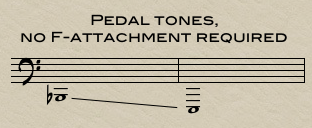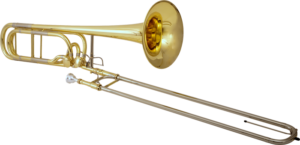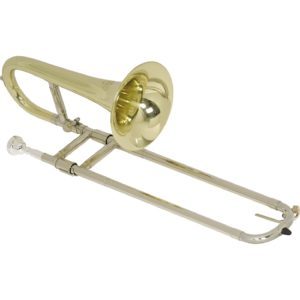
Small-bore vs. large-bore trombones
– the complete guide
A tenor trombone is always tuned in Bb, but unlike the trumpet, it is a non-transposing instrument (probably because trombone players like to call a bone for a bone instead of a Bb for a C). There are two main types of tenor trombones, the small-bore trombone, and the large-bore trombone. Both can be fitted with an F attachment. The bore refers to the actual size of the tubing, measured at the point where you insert the mouthpiece. This results in the need for two series of mouthpieces, built to fit either small or large bore horns.
The small-bore trombone is typically used by jazz players and has a bright sound. Due to the larger tubing, the large-bore trombone has a more mellow and full sound and is the first choice among classical trombone players. I use to describe the difference in sound by comparing the sound of a jazz or pop singer with an opera singer’s, although the difference is not that big when comparing small-bore and large-bore trombones. But just like with the singers, the different trombone models are inherently more suited for some genres than others. Playing jazz on a large-bore trombone can feel a bit clumsy and heavy while playing classical music on a small-bore trombone typically will feel too light and slim-sounding.
Small-bore trombone

Small-bore trombones, often called jazz trombones, usually have a bore spanning between .480′′ to around .510′′ (or 12,2- 13mm), and the bell size is usually between 6,5′′-8′′ (165-203mm). The typical mouthpieces used with small-bore horns have the size of a Bach 11 (small) to Bach 6 1/2 (medium-large). Some trombones have dual-bore, meaning that the two tubes on the slides have slightly different sizes, the one with the mouthpiece attached to it being slightly narrower.
Small-bore jazz trombones rarely have F-attachment, but it is not uncommon on medium-sized jazz trombones (8′′ bell). There are a lot of well-known small-bore trombones on the market, including a bunch of top-notch hand-built instruments by manufacturers like Shires, Rath, Greenhoe, and Edwards. There are also a number of well-known trombone manufacturers that have been around for many decades, such as King, Conn, Bach, Getzen, and Yamaha. Some famous models include:
- King 2B .481/.491 dual-bore, 7.38′′ bell (the Silver Sonic model with a genuine sterling silver bell being the most sought-after)
- Bach 16 .495′′/.509′′ dual-bore, 7.5′′ bell
- Conn 6H .500′′ bore, 8′′ bell
- King 3B .508′′ bore, 8′′ bell
- Bach 36 .525′′ bore, 8′′ bell (semi-large trombone, still using small-bore mouthpiece)
The range on a small bore trombone starts on the low E, going up as high as your chops will allow. This is the actual useable range:

The extreme low range consists of the pedal tones, available one octave below the root on each position, ranging from Bb down to E. Although pedal tones are playable on small-bore trombones, the deepest ones are not very useful.

Large bore trombone
Large-bore trombones, or symphonic trombones, usually have a .547′′ bore and a bell size of 8.5′′ (215mm). Typical mouthpieces used with large bore horns are Bach 6 1/2 (medium-small) via Bach 4 or 5 (medium-large) to Bach 3 (large) or the equivalent from other mouthpiece brands.
F-attachement
Most large-bore instruments have an F-attachment, making the lower range more accessible. Where the small-bore horns have a light and agile feel and tone, the large bore trombones have a darker, full sound with better control of the low range, making them more suited for symphonic music. On trombones without F-attachment, there is a gap in the range between low E and the pedal Bb due to the physics of the instrument. This is solved with the F-attachment (except for the low B which is still missing, go fetch a bass trombone!). When you deploy the F valve, the air is led through the extra tubing. Pressing the F-vale with the slide on first position gives the trombone the same length tubing as if the slide was on 6th position.

On trombones without F-attachment, there is a gap in the range between low E and the contra Bb. This is solved with the F-attachment (except for the contra B which is still missing).

Since the F-attachment makes the overall tubing of the trombone longer, the distance between the slide positions is not exactly the same as without the F attachment activated. This results in only 6 available positions when the F-attachment is activated due to the changed proportions of the instrument.
Newer trombones often have a so-called open wrap F-attachment, making the instrument more responsive and minimizing the difference between playing with and without the attachment activated. Most trombone manufacturers make both large-bore and small-bore trombones. Well-known models include:
- Conn 88 .547′′ bore, 8.5′′ bell
- Bach 42 .547′′ bore, 8.5′′ bell
- Yamaha YSL682 .547′′ bore, 8.5′′ bell
Bass trombone
Unlike most other bass variants of an instrument (such as bass clarinet or bass recorder), Bass trombones are actually tuned the as regular tenor trombones but have significantly larger tubing and bells. Bass trombones are also large bore trombones, but usually, they have both an F and D-attachment and are fitted with larger mouthpieces (typical Bach 1.5G or even larger). They usually have a .562′′ bore and bells ranging from 9,5′′ to 10,5′′ (241-266mm). The extra attachment makes it easier and more convenient to use the low range, and the low B is now available.

If you think about the good bass trombone players you know, chances are great that they also have a deep speaking voice – is it that players with a deep voice are better suited to play bass trombone, or does the instrument encourage their deep voice over time? I think having a deeper voice often means having a more open and relaxed throat which is beneficial for bass trombone playing – but I am not sure about this. Please share your thoughts on this.
Alto trombone

The alto trombone is the least known modeling the family and is smaller and tuned higher than tenor trombones. Where the tenor has a Bb as the fundamental on the first position, the alto trombone has an Eb a fourth above. Alto trombones are mainly used in classical music. A common alto trombone size is 470′′ bore with a 7′′ bell. A standard small-bore mouthpiece will fit. It’s a cute little thing that has a distinctive sound, but make sure you don’t pull the slide off when reaching for 7th position!
Contrabass trombone

The contrabass trombone is a rare but intriguing species, usually tuned a fourth below the tenor trombone making F the fundamental of the first position. They usually have two valves, making up for the fact that only major league basketball players would be able to reach 7th position… The length of the spit valve is a good indicator of the size of the beast. A fully grown contrabass trombone can weigh as much as an African elephant. Or thereabout.
Soprano trombone (or slide trumpet)

The soprano trombone is basically a trumpet with a slide. It is tuned one octave higher than the standard tenor trombone. Since it uses a trumpet mouthpiece, it is quite different to play than a regular trombone. The bore is usually around .450′′ and the bell is the size of a trumpet bell, and the slide often only has six positions. Due to the different embouchure, the soprano trombone is usually played by trumpeters, but rarely very well… Soprano trombones make for great Christmas tree ornaments too.
Summary
I hope that you find this guide useful. If you are new to the world of trombones, you might not even have thought about the different sizes available. There is nothing stopping you from playing on a variety of trombone models and sizes, but most players have their preferred size which they give the most attention. I was once told that if you mostly play on a large bore tenor trombone, make sure that is the last trombone you practice on each day.
Please leave a comment with your thoughts about your preferred trombone models! And as always, correct me if I got something wrong, such as my opinions…
All the best,
Anders Larson, founder of digitaltrombone.com





